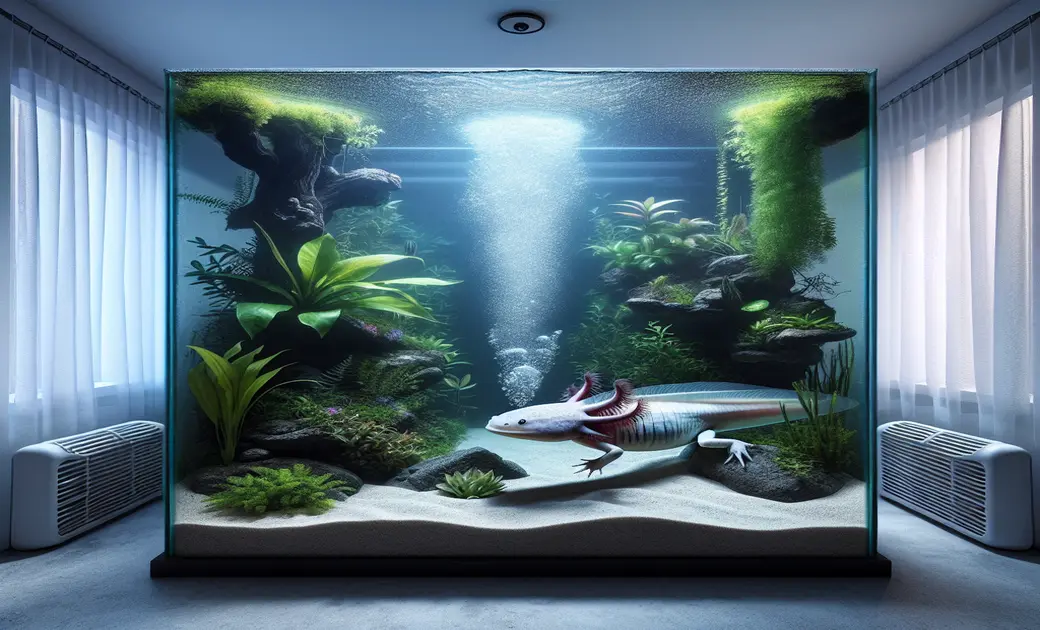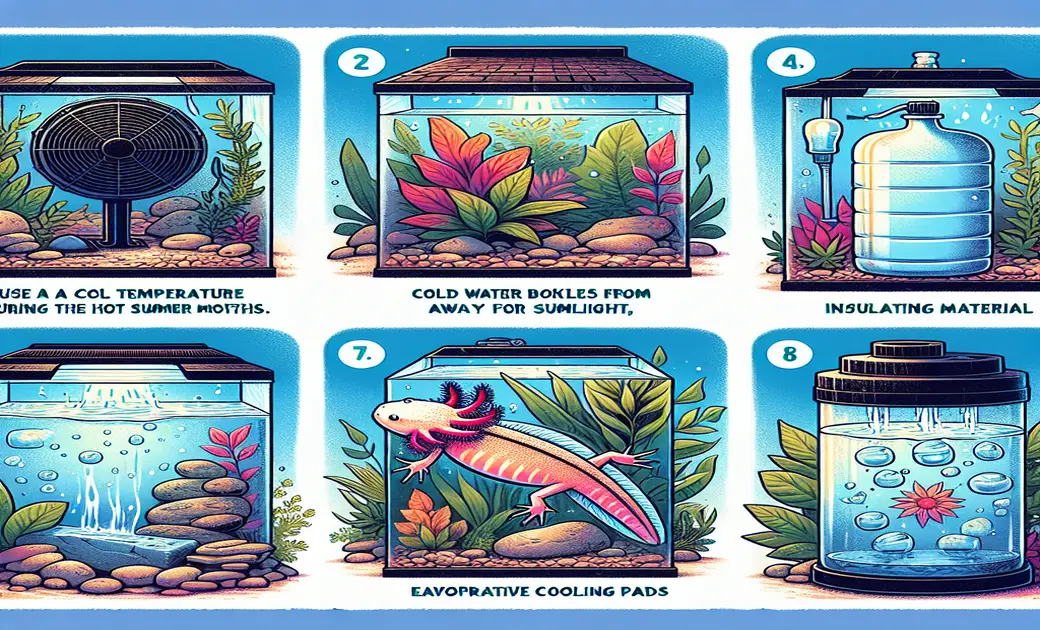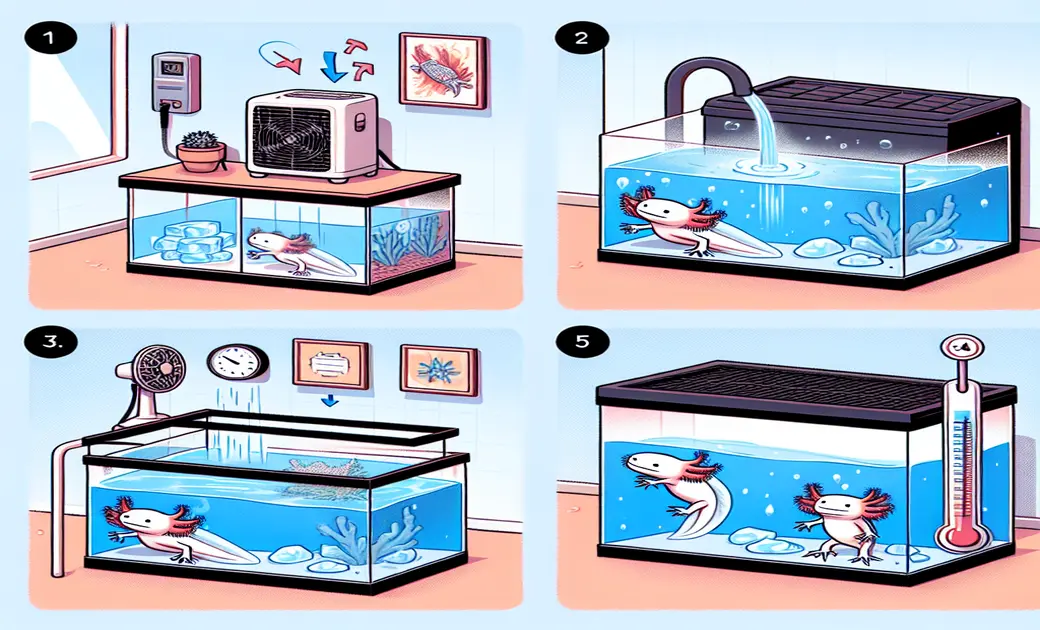Introduction
Axolotls are fascinating aquatic pets known for their adorable gills and unique appearance. However, owning an axolotl comes with specific responsibilities, particularly in maintaining the right water temperature. While aquarium chillers are effective in keeping the tank cool, they can be quite pricey. Fortunately, there are several budget-friendly alternatives to help keep your axolotl tank cool during the hot summer months.
In this blog post, we’ll explore five practical ways to keep your axolotl tank cool without breaking the bank. From using household items to strategic tank placement, these tips will ensure your axolotl stays comfortable and healthy.

What Is an Axolotl?
Axolotls, also known as Mexican walking fish, are a type of salamander native to the Xochimilco lake complex in Mexico. These unique creatures are popular pets due to their distinctive features, including feathery gills and the ability to regenerate limbs. However, replicating their natural habitat conditions is crucial for their well-being.
In their natural habitat, axolotls thrive in dark, cool waters. The water temperature in the Xochimilco lakes typically stays below 70°F, providing a stable and comfortable environment for these amphibians. As pet owners, it’s essential to maintain similar conditions in your home tank to ensure your axolotl’s health and happiness.
Why Keeping Axolotl Tanks Cool Is Crucial
Axolotls are sensitive to temperature changes, and their water needs to stay consistently cool, ideally under 70°F. Warm water can stress axolotls, leading to various health issues such as decreased appetite, reduced growth, and increased susceptibility to diseases.
Maintaining a consistent tank temperature is vital for preventing stress and ensuring your axolotl’s overall well-being. Rapid temperature fluctuations can be harmful, so it’s essential to implement cooling methods that provide gradual and consistent changes.

Best Budget-Friendly Ways to Keep an Axolotl Tank Cool
Use a Fan
One of the simplest and most effective ways to cool your axolotl tank is by using a fan. Aquarium fans work by promoting evaporation, which helps lower the water temperature. By directing a gentle airflow over the water surface, you can reduce the temperature by up to 8°F.
If you don’t have an aquarium fan, you can use a desk or stroller fan as a cost-effective alternative. Just ensure the fan is positioned safely away from the water to prevent any accidents. Using a fan in conjunction with other cooling methods can provide optimal results.
Frozen Water Bottles
Another practical method to cool your axolotl tank is by using frozen water bottles. Here’s a step-by-step guide:
- Fill several plastic water bottles with water and freeze them.
- Once frozen, place one bottle in the tank, allowing it to float on the water surface.
- Monitor the tank temperature and remove the bottle once the desired temperature is reached.
- Rotate the frozen bottles to maintain a consistent cool temperature.
Using frozen water bottles is an effective way to gradually lower the tank temperature without causing sudden fluctuations. Combining this method with a fan can enhance the cooling effect.

Keep Your Axolotl Tank in a Cool Spot
The placement of your axolotl tank plays a significant role in maintaining its temperature. Ideally, place the tank in a cool spot away from windows, direct sunlight, and heat sources like kitchens or electronic devices.
Opt for areas near air conditioners or ceiling fans to keep the ambient temperature low. Keeping the tank in a naturally cooler part of your home can significantly reduce the need for additional cooling methods.
Use Aquarium Plants
Incorporating floating plants into your axolotl tank can help keep the water cool and provide shade. Plants such as Duckweed, Water Cabbage, and Amazon Frogbit are excellent choices for creating a natural, cool habitat.
These plants not only help regulate the temperature but also enhance the aesthetic appeal of the tank. Additionally, they provide hiding spots for your axolotl, mimicking their natural environment and reducing stress.
Turn Up the AC
Maintaining a cool ambient room temperature is crucial for keeping your axolotl tank cool. Aim to keep the room temperature around 70°F by using air conditioning. This helps ensure the tank water stays within the optimal temperature range.
During extreme heat, it may be challenging to maintain the desired temperature. However, using a combination of air conditioning and other cooling methods mentioned above can help keep your axolotl comfortable.

What Not to Do
Avoid Using Cold Water Replacements
While it may be tempting to use cold water replacements to cool your tank quickly, this method can be risky. Sudden temperature changes can shock your axolotl, leading to stress and potential health issues.
Gradual temperature adjustments are safer and more effective. Avoid disrupting the nitrogen cycle in your tank by sticking to consistent, smaller water changes rather than large replacements.
Understanding the Nitrogen Cycle
The nitrogen cycle is a crucial aspect of maintaining a healthy axolotl tank. This biological process involves converting harmful ammonia into less toxic substances through beneficial bacteria.
Sudden, large water replacements can disrupt the nitrogen cycle, leading to a spike in ammonia levels. To maintain a stable environment, it’s recommended to perform regular 25% water changes, ensuring the tank remains clean without causing drastic temperature fluctuations.

Conclusion
Keeping your axolotl tank cool during the summer is essential for their health and well-being. By implementing these budget-friendly methods, you can ensure your axolotl stays comfortable without the need for expensive aquarium chillers.
Consistency and gradual changes are key to maintaining the right temperature. Remember to monitor the tank regularly and adjust your cooling methods as needed. With these tips, you can provide a safe and cool environment for your axolotl year-round.
FAQs
Why can’t I use ice cubes to cool down the axolotl tank?
Ice cubes can cause sudden temperature fluctuations, which can shock your axolotl. It’s better to use methods that provide gradual cooling, such as frozen water bottles.
How often should I change the water in an axolotl tank during summer?
Regular 25% water changes are recommended to maintain a stable environment and prevent disruptions to the nitrogen cycle.
Can I keep my axolotl tank in the basement to keep it cool?
Yes, basements are often cooler and can be an ideal location for your axolotl tank, provided it’s not too cold or damp.
Is it okay to turn off the fan at night when cooling the tank?
It’s best to keep the fan running to maintain a consistent temperature. If turning it off is necessary, monitor the tank temperature closely to ensure it remains stable.
How do I know if my axolotl is stressed from high temperatures?
Signs of stress in axolotls include reduced appetite, lethargy, and visible changes in behavior. Monitoring the tank temperature and making necessary adjustments can help prevent stress.



